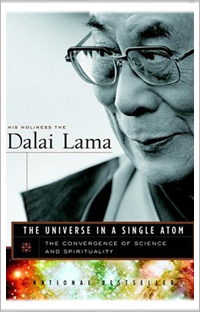By Connie Nardini
The Dalai Lama/The Universe In a Single Atom
Do you know what E=MC[2] means? Have you always wanted to? At least for bragging rights? The Dalai Lama does, and he can explain it from a non-mathematician’s viewpoint.
Really.
The subtitle of his book is “The Convergence of Science and Spirituality.” In this case, the spirituality means his deep understanding of Buddhism. The Dalai Lama has spent much of his time, since being exiled from Tibet, traveling the world and meeting scientists of every political persuasion to discuss with them their theories and discoveries. Now, this is a man who grew up in a palace of too many rooms for him to ever visit, a childhood devoted to learning all the ancient writings of Buddhists from Buddha himself on down. And the story of how he became the Dalai Lama sounds like some kind of voodoo to Western minds.
 Nevertheless . . . that story goes like this: When he was four, he was found in a rural village by a group of monks who were seeking the next Tibetan leader. He was administered the test: Could he pick out certain objects owned by the former Dalai Lama, like his glasses or prayer beads, from a collection of similar objects? He did. He and his brother were taken to Lhasa to live in the Potala Palace. In his book, he reminisces about his boyhood; he often found himself looking through his telescope at children playing the street in front of the palace and envying them their freedom. But if the product of this upbringing produced the man you find in this book, we are a lucky world indeed.
Nevertheless . . . that story goes like this: When he was four, he was found in a rural village by a group of monks who were seeking the next Tibetan leader. He was administered the test: Could he pick out certain objects owned by the former Dalai Lama, like his glasses or prayer beads, from a collection of similar objects? He did. He and his brother were taken to Lhasa to live in the Potala Palace. In his book, he reminisces about his boyhood; he often found himself looking through his telescope at children playing the street in front of the palace and envying them their freedom. But if the product of this upbringing produced the man you find in this book, we are a lucky world indeed.
Back to physics. The Dalai Lama says, “Scientists and philosophers have to live constantly with conflicting models of reality – the Newtonian model, assuming a mechanical and predictable universe, and relativity and quantum mechanics, assuming a more chaotic universe.” He proceeds to explain the connection with Buddhist thought called “the theory of emptiness” with the discoveries of modern physics about the essential reality of what we see as the world around us.
Buddhists, he says, do not believe that “all things and events, whether material, mental or even abstract concepts like time, are devoid of objective, independent existence.” In other words, we think that the material things we see, our own selves as well, are independent of all other things and persons. In reality, everything is constantly changing – shifting, if you will – so we can’t really put our finger on what it is. Also, physics tells us that what we can see through a microscope changes merely because we are looking at it!
The Dalai Lama tells us that our modern scientists have found this out through countless experiments, while Buddhists discovered these same truths through meditation. He proves this through understandable and easily followed explanations, and comes to the conclusion that we need two ways of finding the truths about reality. Each must depend on and be accountable to the other. The beauty of his writing is his ability to shed many lights on the hard-to-understand ideas of modern physics that he has absorbed through the tutoring of some of the best minds alive.
Trust me when I say you will understand this statement when you finish this book: “Everything is nothing. Nothing is everything!” The Dalai Lama feels the understanding of the science-philosophy link is so important that he is now working to include the study of physics in all Buddhist monasteries. He says, “The earth is our only home . . . The image of a blue planet floating in deep space, glowing like the full moon on a clear night, brought home powerfully to me the recognition that we are indeed all members of a single family sharing one little house.”
The differences we cling to will not help us to preserve it.
–
Previously in Connie’s Corner:
* “Heavier Than Air.” Nona Caspers creates a tapestry of small towns and chronicles the lives of people living there who have a hard time coming down to earth.
* “Pale Fire.” Nabokov creates a novel that doesn’t seem to have coherent plot but a story that contains a do-it-yourself kit.
* “Out Stealing Horses.” A coming-of-age story that reveals a father’s secret life during wartime.
* “An American In Iceland.” Answering the riddle: how many Icelanders does it take to change a light bulb?
Posted on May 27, 2008


